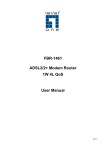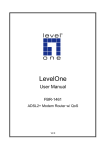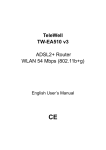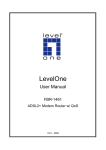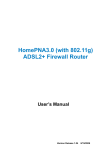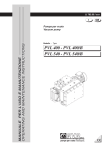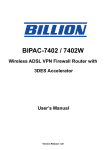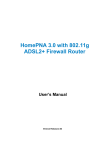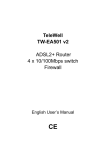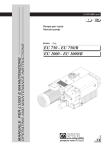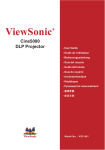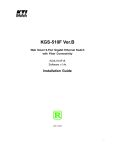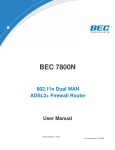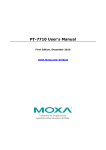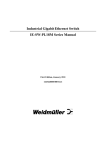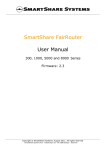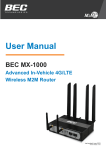Download BEC 6800RUL - BEC Technologies, Inc.
Transcript
BEC 6800RUL 4G/LTE Outdoor Router User Manual Version release: v1.3 Last revised: Sept, 2015 TABLE OF CONTENTS TABLE OF CONTENTS ...................................... 2 CHAPTER 1: INTRODUCTION ................................... 1 INTRODUCTION TO YOUR ROUTER .............................................................. 1 FEATURES & SPECIFICATIONS .................................................................... 2 HARDWARE SPECIFICATIONS ..................................................................... 3 APPLICATION DIAGRAM .......................................................................... 3 CHAPTER 2: PRODUCT OVERVIEW .......................... 4 IMPORTANT NOTE FOR USING THIS ROUTER ................................................ 4 PACKAGE CONTENTS ............................................................................... 4 DEVICE DESCRIPTION .............................................................................. 5 MOUNTING INSTRUCTIONS ...................................................................... 6 CHAPTER 3: BASIC INSTALLATION ..........................13 NETWORK CONFIGURATION – IPV4 ......................................................... 14 Configuring PC in Windows 7 (IPv4) ................................................................ 14 Configuring PC in Windows Vista (IPv4) .......................................................... 16 Configuring PC in Windows XP (IPv4) .............................................................. 18 Configuring PC in Windows 2000 (IPv4) .......................................................... 19 Configuring PC in Windows 98/ME ................................................................. 20 Configuring PC in Windows NT4.0 ................................................................... 21 NETWORK CONFIGURATION – IPV6 ......................................................... 22 Configuring PC in Windows 7 (IPv6) ................................................................ 22 Configuring PC in Windows Vista (IPv6) .......................................................... 24 Configuring PC in Windows XP (IPv6) .............................................................. 26 DEFAULT SETTINGS ............................................................................... 27 CHAPTER 4: BASIC CONFIGURATION ......................28 LOGIN TO YOUR DEVICE ......................................................................... 28 STATUS.............................................................................................. 29 QUICK START ...................................................................................... 30 WAN ............................................................................................... 32 CHAPTER 5: ADVANCED CONFIGURATION..............33 LOGIN TO YOUR DEVICE ......................................................................... 33 STATUS.............................................................................................. 35 Mobile Status .................................................................................................. 36 ARP Table ........................................................................................................ 37 DHCP Table ...................................................................................................... 37 System Log ...................................................................................................... 38 Firewall Log ..................................................................................................... 38 UPnP Portmap ................................................................................................. 39 QUICK START ...................................................................................... 40 CONFIGURATION .................................................................................. 42 LAN - Local Area Network................................................................................ 42 Ethernet ....................................................................................................................... 42 IP Alias.......................................................................................................................... 42 DHCP Server ................................................................................................................. 43 WAN - Wide Area Network .............................................................................. 45 WAN Profile .................................................................................................................. 45 System ............................................................................................................. 50 Time Zone ..................................................................................................................... 50 Firmware Upgrade ....................................................................................................... 51 Backup / Restore .......................................................................................................... 53 Restart Router .............................................................................................................. 53 User Management ....................................................................................................... 54 Mail Alert ..................................................................................................................... 55 Firewall and Access Control ............................................................................. 56 Packet Filter .................................................................................................................. 57 MAC Filter..................................................................................................................... 59 Intrusion Detection ....................................................................................................... 60 Block WAN PING ........................................................................................................... 62 URL Filter ...................................................................................................................... 62 QoS - Quality of Service ................................................................................... 65 Quality of Service Introduction ..................................................................................... 65 QoS Setup ..................................................................................................................... 65 Virtual Server .................................................................................................. 70 Port Mapping ............................................................................................................... 71 DMZ ............................................................................................................................. 73 Time Schedule ................................................................................................. 75 ADVANCED ......................................................................................... 76 Static Route .................................................................................................................. 76 Static ARP ..................................................................................................................... 76 Dynamic DNS ................................................................................................................ 77 Device Management .................................................................................................... 78 SIP_ALG ........................................................................................................................ 85 IGMP ............................................................................................................................ 85 SNMP Access Control .................................................................................................... 86 TR-069 Client ................................................................................................................ 88 Remote Access .............................................................................................................. 89 SAVE CONFIGURATION TO FLASH ............................................................. 90 RESTART ............................................................................................ 91 LOGOUT............................................................................................. 92 CHAPTER 6: TROUBLESHOOTING ...........................93 Problems with the Router ............................................................................... 93 Problem with LAN Interface ............................................................................ 93 Recovery Procedures ....................................................................................... 94 APPENDIX: PRODUCT SUPPORT & CONTACT ..........95 Introduction 1 CHAPTER 1: INTRODUCTION Introduction to your Router Thank you for purchasing BEC 6800RUL 4G_LTE Outdoor Router. This unit is a light-weight, an industrial-grade outdoor fixed wireless router with an IP67 rated enclosure to withstand extreme weather conditions and harsh rugged deployments. With integrated IEEE802.3af power over Ethernet (PoE) support, the 6800RUL provides an easy installation from eliminating the need for a separate power and data cable. In addition to outdoor, it can be installed in environments such as: manufacturing plants, industrial automation, stadiums, convention halls, stadium facilities, school campuses or virtually any venue requiring a robust wireless solution. The 6800RUL integrates a high performance device with an embedded LTE module and advanced IP networking features enabling support of multiple high bandwidth applications at peaks speeds up to 100Mbps downlink and 50Mbps uplink. Lightweight, Compact and unobtrusive Design With multiple mounting options and a light weighted, it is easily to install the 6800RUL by single person. The 6800RUL also has a built-in passive Power of Ethernet (PoE) so both data and power can be sent from the unit. Designed for Challenging / Rugged Deployments The 6800RUL is designed for the toughest industrial environments. With IP67 hardened enclosure with Industrial-grade components, the 6800RUL can be installed in manufacturing plants, industrial automation, stadiums, convention halls, stadium facilities, school campuses, etc. 4G/LTE Mobility With 4G/LTE-based Internet connection (4G/LTE embedded module, requires an additional SIM card), you can access to the Internet through 4G/LTE whether you are seated at your desk or taking a crosscountry trip. 4G/LTE Management Center With the BEC 6800RUL (4G_LTE Outdoor Router), monitoring your 4G connection status is a breeze, unique 4G Management Center is an utility tool displaying its current 4G-signal status visually for users to maximize their connection. You can monitor the bandwidth with the current upload and download speed. This too also calculates the total amount of hours or data traffic used per month, allowing you to manage your 4G monthly subscriptions. Firmware Upgradeable Device can be upgraded to the latest firmware through the WEB based GUI. BEC 6800RUL User Manual Introduction Features & Specifications • 4G embedded with a built-in SIM card slot • High-speed 4G connection up to downlink 100Mbps and uplink 50Mbps data rate • 4G Management Center for connection monitoring • Firewall security with DoS prevention and SPI • Quality of Service control • Syslog monitoring • Ideal for homes, businesses, rural areas and the underserved LTE Antenna Options • Embedded MIMO Directional (700MHz): 6~8dBi OR • Two (2) detachable MIMO N-type: (N Models) OX-7 Antenna (700MHz): 5dBi OX-17 Antenna (1700~2100MHz): 9dBi Network Protocols and Features • NAT, static routing and RIP-1 / 2 • NAT supports PAT and multimedia applications • Transparent bridging • Virtual server and DMZ • SNTP, DNS relay and DDNS • IGMP snooping and IGMP proxy Firewall Management • Built-in NAT Firewall • Stateful Packet Inspection (SPI) • Prevents DoS attacks including Land Attack, Ping of Death, etc. • Remote access control for web base access • IP, MAC, and URL filtering • Password protection for system management • VPN pass-through Quality of Service Control • Supports the DiffServ approach • Traffic prioritization based-on IP protocol, port number and address BEC 6800RUL User Manual 2 Introduction Management • 4G Management Center • Web-based for remote and local management • Firmware upgrades and configuration data upload / download via web-based interface • System Log monitoring • Supports DHCP server / client / relay Hardware Specifications Physical interface • 10/100 Ethernet LAN with IEEE802.3af compliant PoE PD • SIM slot: (for the SIM card from Telco / ISP) • LED Indicators: Power, LAN (PoE), Boot, LTE, and Internet Physical Specifications • Dimensions (W*H*D): 8.5" x 7.5" x 3"(257mm x 227mm x 91mm) • Weight: 2.75kgs (6.06lbs) • IP-67 Grade Enclosure Application Diagram BEC 6800RUL User Manual 3 Product Overview 4 CHAPTER 2: PRODUCT OVERVIEW Important Note for Using This Router Do not remove, open or repair the case yourself. Contact with your Internet Service Provider or have it repaired at a qualified service center. Use the supplied PoE (Power-over-Ethernet) injector for indoor only or with any 802.3at capable PoE injectors to connect with BEC 6800RUL It is mandatory to earth ground the BEC 6800RUL. Improper grounding not only could damage the unit but also all eqiupments connected to it. Attention Package Contents BEC 6800RUL 4G/LTE Outdoor Router This Quick Installation Guide M25 Cable Gland 25ft Outdoor LAN cable PoE Injector Grounding Wire Mounting Kit BEC 6800RUL User Manual Product Overview 5 Device Description DESCRIPTION CONNECTORS SIM/ Reset Insert the SIM card into the SIM slot; press the reset button to reset device or restore to factory default settings LAN(PoE) Connect to a computer/ Passive PoE using an Ethernet cable. DESCRIPTION LED 1. Power Lit green when system power on. 2. LAN(PoE) Lit green when the LAN port is connected to an Ethernet device. Blink when data is being transmitted/ received LED 3. Boot LED Lit green means system boot up successfully. 4. LTE Lit green when 4G/LTE service is ready to precede the dial-up. 5. Internet Lit green when Internet is available. BEC 6800RUL User Manual Product Overview Mounting Instructions 1. Attach the Articulation Pole to the Enclosure Attach the articulation pole to the back of the BEC 6800RUL using M6*16 screws and washers. A -45 or +45 degree adjustment Dual-Polarized Antenna 2. Cross-Polarized Antenna Mounting on Wall or a Pole 2.1 Mounting on Wall Fix the T-formed Bracket to the wall using wood/ drywall screws. 2.2 Mounting on a Pole 2.2.1a Mounting for pole smaller than 1.5” (38mm) Attach the T-formed Bracket and the W-bar to the pole then use M6x60 bolts, spring washer and washer to fix the mounting kit onto the pole. BEC 6800RUL User Manual 6 Product Overview 2.2.1b Mounting for pole larger than 1.5” (38mm) Fix the T-formed Bracket to the pole by using the stainless hose clamp. 2.2.1 Mounting BEC 6800RUL on a Pole with T-formed Bracket Attach the articulation pole to the T-formed bracket by using M8x40 bolts, nut, spring washer and washer. Dual-Polarized Antenna – The original of the source position, the nominal position, is seeing BEC logo when facing toward the 6800RUL, Cross-Polarized Antenna – From the nominal position, adjusting and rotating the 6800RUL -45 or +45, anticlockwise or clockwise, degree angle. BEC 6800RUL User Manual 7 Product Overview 3. Position Adjustment 3.1 Using an Embedded Directional Antenna 3.1.1 Find the location and best angle for getting the strongest signal from the base station. The CPE must be directed towards the nearest base station. 3.3.2 Adjusting CPE position to get a better reception and/or fine-tuning the CPE orientation (in horizontal/vertical position or 45 degree angle position) to have the best signal strength 3.2 Using two (2) Omni Directional Antennas BEC 6800RUL User Manual 8 Product Overview 3.2.1 Find the location and best angle for getting the strongest signal from the base station. The CPE must be directed towards the nearest base station. 3.3 Using an External Yagi Antenna Find a good spot to mount the Yagi antenna, such as a chimney or rooftop, to avoid trees, building, and any metal objects. The Yagi antenna must be directly pointing to the nearest base station for strongest signals. 4. Grounding the CPE to Complete the Installation Attach the grounding wire to the CPE and tighten the screw BEC 6800RUL User Manual 9 Product Overview 5. Power on your LTE router Step 1: Assemble M25 cable gland Step 2: Unscrew the LAN (PoE) port and insert the supplied outdoor Ethernet cable (RJ-45) through material A-D, and then connect the RJ-45 Ethernet cable into the CPE port. Step 3: 3.1: Insert ○ C at the back end of ○ D 3.2: clip ○ B on ○ C 3.3: keep ○ B close to ○ D 3.4: then tighten ○ A. BEC 6800RUL User Manual 10 Product Overview Step 4: Insert the other end of outdoor Ethernet cable (RJ-45) to the supplied PoE injector P+D/OUT port. Connect another Ethernet cable (RJ-45) directly to the Data/IN port and the other end of cable to a switch or broadband router. Plug the PoE power cable to an electrical outlet to power on your LTE router. IMPORTANT: It is recommended to put the PoE Injector on an UPS or Surge Protector. Use the supplied grounding wire to ground your 6800RUL ODU is REQUIRED! 6. Set up your LTE Internet Connection Step 1: Unscrew the cap of SIM card slot. Step 2: Slide the SIM card into the card slot of the device. Make sure that the SIM card is slid into the bottom of the slot with a click. IMPORTANT: It is recommended to use an industrial grade SIM card. BEC 6800RUL User Manual 11 Product Overview Step 3: Screw the cap back tightly. Warning BEC 6800RUL User Manual Please power off the device before inserting or removing the SIM card. 12 Basic Installation 13 CHAPTER 3: BASIC INSTALLATION The router can be configured with your web browser. A web browser is included as a standard application in the following operating systems: Windows 98 / NT /2000 / XP / ME / 7 / Vista, Linux, Mac OS, etc. The product provides an easy and user-friendly interface for configuration. PCs must have an Ethernet interface installed properly and be connected to the router either directly or through an external repeater hub, and have TCP/IP installed or configured to obtain an IP address through a DHCP server or a fixed IP address that must be in the same subnet as the router. The default IP address of the router is 192.168.1.254 and the subnet mask is 255.255.255.0 (i.e. any attached PC must be in the same subnet, and have an IP address in the range of 192.168.1.1 to 192.168.1.253). The best and easiest way is to configure the PC to get an IP address automatically from the router using DHCP. If you encounter any problems accessing the router’s web interface it may also be advisable to uninstall any kind of software firewall on your PCs, as they can cause problems accessing the 192.168.1.254 IP address of the router. Users should make their own decisions on how to best protect their network. Please follow the steps below for your PC’s network environment installation. First of all, please check your PC’s network components. The TCP/IP protocol stack and Ethernet network adapter must be installed. If not, please refer to your Windows-related or other operating system manuals. Any TCP/IP capable workstation can be used to communicate with or through the BEC 6800RUL. To configure other types of workstations, please consult the manufacturer’s documentation. BEC 6800RUL User Manual Basic Installation Network Configuration – IPv4 Configuring PC in Windows 7 (IPv4) 1. Go to Start. Click on Control Panel. 2. Then click on Network and Internet. 3. When the Network and Sharing Center window pops up, select and click on Change adapter settings on the left window panel. 4. Select the Local Area Connection, and right click the icon to select Properties. BEC 6800RUL User Manual 14 Basic Installation 5. Select Internet Protocol Version 4 (TCP/IPv4) then click Properties. 6. In the TCP/IPv4 properties window, select the Obtain an IP address automatically and Obtain DNS Server address automatically radio buttons. Then click OK to exit the setting. 7. Click OK again in the Local Area Connection Properties window to apply the new configuration. BEC 6800RUL User Manual 15 Basic Installation Configuring PC in Windows Vista (IPv4) 1. Go to Start. Click on Network. 2. Then click on Network and Sharing Center at the top bar. 3. When the Network and Sharing Center window pops up, select and click on Manage network connections on the left window pane. 4. Select the Local Area Connection, and right click the icon to select Properties. BEC 6800RUL User Manual 16 Basic Installation 5. Select Internet Protocol Version 4 (TCP/IPv4) then click Properties. 6. In the TCP/IPv4 properties window, select the Obtain an IP address automatically and Obtain DNS Server address automatically radio buttons. Then click OK to exit the setting. 7. Click OK again in the Local Area Connection Properties window to apply the new configuration. BEC 6800RUL User Manual 17 Basic Installation Configuring PC in Windows XP (IPv4) 1. Go to Start. Click on Control Panel. 2. Then click on Network and Internet. 3. In the Local Area Connection Status window, click Properties. 4. Select Internet Protocol (TCP/IP) and click Properties. 5. Select the Obtain an IP address automatically and the Obtain DNS server address automatically radio buttons. 6. Click OK to finish the configuration. BEC 6800RUL User Manual 18 Basic Installation Configuring PC in Windows 2000 (IPv4) 1. Go to Start / Settings / Control Panel. In the Control Panel, double-click on Network and Dial-up Connections. 2. Double-click Local Area Connection. 3. In the Local Area Connection Status window click Properties. 4. Select Internet Protocol (TCP/IP) and click Properties. 5. Select the Obtain an IP address automatically and the Obtain DNS server address automatically radio buttons. 6. Click OK to finish the configuration. BEC 6800RUL User Manual 19 Basic Installation Configuring PC in Windows 98/ME 1. Go to Start / Settings / Control Panel. In the Control Panel, double-click on Network and choose the Configuration tab. 2. Select TCP/IP ->NE2000 Compatible, or the name of your Network Interface Card (NIC) in your PC. 3. Select the Obtain an IP address automatically radio button. 4. Then select the DNS Configuration tab. 5. Select the Disable DNS radio button and click OK to finish the configuration. BEC 6800RUL User Manual 20 Basic Installation Configuring PC in Windows NT4.0 1. Go to Start / Settings / Control Panel. In the Control Panel, double-click on Network and choose the Protocols tab. 2. Select TCP/IP Protocol and click Properties. 3. Select the Obtain an IP address from a DHCP server radio button and click OK. BEC 6800RUL User Manual 21 Basic Installation Network Configuration – IPv6 Configuring PC in Windows 7 (IPv6) 1. Go to Start. Click on Control Panel. 2. Then click on Network and Internet. 3. When the Network and Sharing Center window pops up, select and click on Change adapter settings on the left window panel. 4. Select the Local Area Connection, and right click the icon to select Properties. BEC 6800RUL User Manual 22 Basic Installation 5. Select Internet Protocol Version 6 (TCP/IPv6) then click Properties. 6. In the TCP/IPv6 properties window, select the Obtain an IPv6 address automatically and Obtain DNS Server address automatically radio buttons. Then click OK to exit the setting. 7. Click OK again in the Local Area Connection Properties window to apply the new configuration. BEC 6800RUL User Manual 23 Basic Installation Configuring PC in Windows Vista (IPv6) 1. Go to Start. Click on Network. 2. Then click on Network and Sharing Center at the top bar. 3. When the Network and Sharing Center window pops up, select and click on Manage network connections on the left window pane. 4. Select the Local Area Connection, and right click the icon to select Properties. BEC 6800RUL User Manual 24 Basic Installation 5. Select Internet Protocol Version 6 (TCP/IPv6) then click Properties. 6. In the TCP/IPv6 properties window, select the Obtain an IP address automatically and Obtain DNS Server address automatically radio buttons. Then click OK to exit the setting. 7. Click OK again in the Local Area Connection Properties window to apply the new configuration. BEC 6800RUL User Manual 25 Basic Installation 26 Configuring PC in Windows XP (IPv6) IPv6 is supported by Windows XP, but you need to install it first. Please follow the steps to install IPv6: 1. On the Desktop, Click Start > Run, type cmd, then press Enter key in the keyboard, the following screen appears. 2. Key in command ipv6 install Installation of IPv6 is now completed. Please test it to see if it works or not. . BEC 6800RUL User Manual Basic Installation Default Settings Before configuring the router, you need to know the following default settings. Web Interface: (Username and Password) Username: admin Password: admin The default username and password are “admin” and “admin” respectively. Attention If you ever forget the username/password to login to the router, you may press the RESET button up to 6 seconds then release it to restore the factory default settings. Caution: After pressing the RESET button for more than 6 seconds then release it, to be sure you power cycle the device again. Device LAN IP Settings IP Address: 192.168.1.254 Subnet Mask: 255.255.255.0 DHCP Server: DHCP server is enabled. Start IP Address: 192.168.1.100 IP pool counts: 100 BEC 6800RUL User Manual 27 Basic Configuration / Login to GUI 28 CHAPTER 4: BASIC CONFIGURATION Login to your Device Open your web browser, enter the IP address of your router, which by default is 192.168.1.254, and click “Go”, a user name and password window prompt appears. Enter the user name and password that your administrator has set for you and select the Account Type, then click Login. The default username and password is “admin” and “admin” respectively for the Administrator account type. NOTE: This username / password may vary by different Internet Service Providers. Congratulations! You have successfully logged on to your BEC 6800RUL. Once you have logged on to your router via your web browser, you can begin to set it up according to your requirements. On the configuration homepage, the left navigation pane links you directly to the setup pages, which includes: Advanced (Click to switch to the Advanced Configuration Mode) Status Quick Start WAN BEC 6800RUL User Manual Basic Configuration / Status Status Device Information Model Name: Provide a name for the router for identification purposes. System Up-Time: Record system up-time. Software Version: Firmware version. Port Status Port Status:User can look up to see if they are connected to Ethernet and 3G / 4G_LTE WAN Port: Name of the WAN connection. Protocol: PPPoE, Dynamic or Fixed for WAN Operation: Current available operation. Connection: The current connection status. IP Address: WAN port IP address. Netmask: WAN port IP subnet mask. Gateway: The IP address of the default gateway. Primary DNS: The IP address of the primary DNS server. BEC 6800RUL User Manual 29 Basic Configuration / Quick Start Wiazrd 30 Quick Start This is a useful and easy utility to help you to setup the router quickly and to connect to your ISP (Internet Service Provider) with only a few steps. It will guide you step by step to setup time zone and WAN settings of your device. The Quick Start Wizard is a helpful guide for the first-time users to the device. Step 1 – Time Zone Enable and Select the appropriate Time Zone, then click Continue to go on to next step. You can turn Time Zone to understand more. Step 2 – WAN Click Continue to enter your SIM card inform for registration. Enter your SIM card telephone number, APN, Username, Password, PIN, etc. If you have trouble to find these information, please consult with your SIM carrier. BEC 6800RUL User Manual Basic Configuration / Quick Start Wiazrd 31 Note: when re-inserting the 3G / 4G SIM card to the BEC 6800RUL, you should again press Continue button to make 3G / 4G connection take effort, or you can Save Config and Restart the router to reach the same effort. Step 3 – Configuration in Process The 6800RUL will take 15~30 seconds to configure the settings. Once it is done, you will see a “Configurations!” window. Step 4 – Quick Start Completed! You now may be able to access to the Internet. If not, please check your WAN, Internet Connection, setup again. To review the WAN connection, please go back to Status for more information. BEC 6800RUL User Manual Basic Configuration / WAN 32 WAN IP Pass-through Mode: When enabled, BEC 6800RUL is in bridge mode that it does not obtain a WAN IP address; features such as routing capabilities, NAT, firewall, etc., are being disabled. The client router that is behind the BEC 6800RUL now obtains a WAN IP address. When disabled, BEC 6800RUL is in router mode that it handles a WAN IP address and all features are become available. ISP Mode: A list of 3G / 4G service providers that is available. APN: An APN is similar to a URL on the WWW, it is what the unit makes a GPRS / UMTS / LTE call. The service provider is able to attach anything to an APN to create a data connection. Requirements for APN assignment varies between different service providers. Most service providers have an internet portal which they connect a DHCP Server to, giving you access to the internet i.e. Some 3G / 4G operators use the APN ‘internet’ for their portal. The default value of APN is “broadband”. Username: Enter the username provided by your service provider. Password: Enter the password provided by your service provider. Authentication Protocol: Manually specify CHAP (Challenge Handshake Authentication Protocol) or PAP (Password Authentication Protocol) if you know which authentication type the server is using (when acting as a client), or the authentication type you want the clients to use when they are connecting to you (when acting as a server). When using PAP, the password is sent unencrypted, while CHAP encrypts the password before sending, and also allows for challenges at different periods to ensure that an intruder has not replaced the client. PIN: PIN stands for Personal Identification Number. A PIN code is a numeric value used in certain systems as a password to gain access, and authentication. In mobile phones a PIN code locks the SIM card until you enter the correct code. If you enter the PIN code incorrectly into the phone 3 times in a row, then the SIM card will be blocked and a PUK code will be required from your network / service provider to unlock it. NOTE: when the 3G / 4G SIM card is pulled out and then insert into again, you should again press Apply button to make 3G / 4G connection take effort, or you can Save config and Restart the route to reach the same effort. BEC 6800RUL User Manual Advanced Configuration / Login to GUI 33 CHAPTER 5: ADVANCED CONFIGURATION Login to your Device Open your web browser, enter the IP address of your router, which by default is 192.168.1.254, and click “Go”, a user name and password window prompt appears. Enter the user name and password that your administrator has set for you and select the Account Type, then click Login. The default username and password is “admin” and “admin” respectively for the Administrator account type. NOTE: This username / password may vary by different Internet Service Providers. Congratulations! You have successfully logged on to your BEC 6800RUL. BEC 6800RUL User Manual Advanced Configuration / Login to GUI 34 Once you have logged on to your BEC 6800RUL via your web browser, you can begin to set it up according to your requirements. On the configuration homepage, the left navigation panel links you directly to each feature contents, which include: Quick Start Section Status Configuration (Wizard Setup) Mobile Status LAN - Ethernet - IP Alias - DHCP Server ARP Table WAN - WAN Profile DHCP Table System - Time Zone - Firmware Upgrade - Backup / Restore - Restart - User Management - Mail Alert System Log Firewall - Packet Filter - MAC Filter - Intrusion Detection - Block WAN Ping - URL Filter Firewall Log QoS UPnP Portmap Virtual Server - Port Mapping - DMZ SubItems Time Schedule Advanced - Static Route - Static ARP - Dynamic DNS - Device Management - SIP_ALG - IGMP - SNMP Access Control - TR-069 Client - Remote Access The following sections provide details explanation and configuration of the settings available in the BEC 6800RUL router. BEC 6800RUL User Manual Advanced Configuration / Status 35 Status Device Information Model Name: Display the model name. Host Name: Provide a name for the router for identification purposes. Host Name lets you change the router name. Click this link to turn to Device Management configuration. System Up-Time: Record system up-time. Current time: Set the current time. See the Time Zone section for more information. Click this link to turn to Time Zone configuration. Software Version: Firmware version. MAC Address: The LAN MAC address. Port Status Port Status:Display available connection interfaces that are supported in the BEC 6800RUL. Users can look up the status of each interface. WAN Port: List current available WAN connections. Operation: Current available operation. Connection: The current connection status. IP Address: WAN port IP address. Netmask: WAN port IP subnet mask. Gateway: The IP address of the default gateway. Primary DNS: The IP address of the primary DNS server. BEC 6800RUL User Manual Advanced Configuration / Status 36 Mobile Status This section displays the 3G / 4G Card overall status with information such as the current signal strength, statistics of current data transmission and total data transmission. Status: The current status of the 3G/4G-LTE connection. Signal Strength: The signal strength bar indicates the current 3G/4G signal strength. SIM Card Status: It indicates if the SIM Card is being inserted correctly or not. If SIM card is not installed properly or cannot be detected, “SIM Card Not Found” will be displayed. Network ID / Name: The network ID and/or name that the SIM card is connected to. Cell ID: The information of Cell ID. Card IMEI: The unique identification number that is used to identify the 3G / 4G card. Card IMSI: The international mobile subscriber identity used to uniquely identify the 3G / 4G card Network Mode: Show the using network mode. Network Band: Show the using network band. Current TX Bytes / Packets: The statistics of data transmission in bytes / packets during a call. Current RX Bytes / Packets: The statistics of data received in bytes / packets during a call. Total TX Bytes / Packets: The statistics of total data transmission in bytes / packets since system ready. Total RX Bytes / Packets: The statistics of total data received in bytes / packets since system ready. Amount used: Show the traffic or hours has been used. BEC 6800RUL User Manual Advanced Configuration / Status 37 Billing period: The day from which the fee is charged. ARP Table This section displays the router’s ARP (Address Resolution Protocol) Table, which shows the mapping of Internet (IP) addresses to Ethernet (MAC) addresses. This is useful as a quick way of determining the MAC address of the network interface of your PCs to use with the router’s Firewall / MAC Address Filter function. See the Firewall section of this manual for more information on this feature. IP Address: It is IP Address of internal host that join this network. MAC Address: The MAC address of internal host. Interface: indicates which side the IP addresses locate on. WAN means the corresponding IP locates on WAN side. Static ARP: The state for ARP. “No” for dynamically-generated ARP table entries. “Yes” for static ARP table entries added by the user. DHCP Table IP Address: The current corresponding DHCP-assigned dynamic IP address of the device. Click this link to configure DHCP Server, for more information, turn to Page 63-64. MAC Address: The MAC Address of internal DHCP client host. Client Host Name: The Host Name of internal DHCP client. Register Information: Register time information. BEC 6800RUL User Manual Advanced Configuration / Status 38 System Log Display system logs accumulated up to the present time. You can trace historical information with this function. Firewall Log Firewall Log displays log information of any unexpected action with your firewall settings. This page displays the router’s Firewall Log entries. The log shows log entries when you have enabled Intrusion Detection or Block WAN PING in the Configuration / Firewall section of the interface. Please see the Firewall section of this manual for more details on how to enable Firewall logging. BEC 6800RUL User Manual Advanced Configuration / Status 39 UPnP Portmap The section lists all port-mapping established using UPnP (Universal Plug and Play). Please see the Advanced Configuration section of this manual for more details on UPnP and the router’s UPnP configuration options. Name: the name of this UPnP mapping. Protocol: the protocol used by this mapping. External Port: the external service port the internal port mapped to. Internal Port: the internal service port. IP Address: the IP Address of the host in LAN. BEC 6800RUL User Manual Advanced Configuration / Quick Start Wizard 40 Quick Start This is a useful and easy utility to help you to setup the router quickly and to connect to your ISP (Internet Service Provider) with only a few steps. It will guide you step by step to setup time zone and WAN settings of your device. The Quick Start Wizard is a helpful guide for the first-time users to the device. Step 1 – Time Zone Enable and Select the appropriate Time Zone, then click Continue to go on to next step. You can turn Time Zone to understand more. Step 2 – WAN Click Continue to enter your SIM card inform for registration. Enter your SIM card telephone number, APN, Username, Password, PIN, etc. If you have trouble to find these information, please consult with your SIM carrier. BEC 6800RUL User Manual Advanced Configuration / Quick Start Wizard 41 Note: when re-inserting the 3G / 4G SIM card to the BEC 6800RUL, you should again press Continue button to make 3G / 4G connection take effort, or you can Save Config and Restart the router to reach the same effort. Step 3 – Configuration in Process The 6800RUL will take 15~30 seconds to configure the settings. Once it is done, you will see a “Configurations!” window. Step 4 – Quick Start Completed! You now may be able to access to the Internet. If not, please check your WAN, Internet Connection, setup again. To review the WAN connection, please go back to Status for more information. BEC 6800RUL User Manual Advanced Configuration / LAN 42 Configuration Click this item to access the following sub-items that configure the 3G / 4G router: LAN, WAN, System, Firewall, QoS, Virtual Server, Time Schedule, and Advanced. These functions are described in the following sections. LAN - Local Area Network A Local Area Network (LAN) is a shared communication system to which many computers are attached and is limited to the immediate area, usually the same building or floor of a building. Ethernet The router supports more than one Ethernet IP addresses in the LAN, and with distinct LAN subnets through which you can access the Internet at the same time. Users usually only have one subnet in their LAN. The default IP address for the router is 192.168.1.254. IP Address: The IP on this router, default is 192.168.1.254. Netmask: The subnet mask on this router. RIP: RIP v1, RIP v2 Broadcast, RIP v1+v2 Broadcast and RIP v2 Multicast. IP Alias This function allows the creation of multiple virtual IP interfaces on this router. It helps to connect two or more local networks to the ISP or remote node. In this case, an internal router is not required. IP Address: Specify an IP address on this virtual interface. Netmask: Specify a subnet mask on this virtual interface. BEC 6800RUL User Manual Advanced Configuration / LAN 43 DHCP Server You can disable or enable the DHCP (Dynamic Host Configuration Protocol) server or enable the router’s DHCP relay functions. The DHCP protocol allows your router to dynamically assign IP addresses to PCs on your network if they are configured to obtain IP addresses automatically. DHCP Server Mode: Disable To disable the router’s DHCP Server, check Disabled and then click Apply. When the DHCP Server is disabled, you will need to manually assign a fixed IP address to each PC on your network, and set the default gateway for each PC to the IP address of the router (the default is 192.168.1.254). DHCP Server Mode: DHCP Server To configure the router’s DHCP Server, check DHCP Server. You can then configure parameters of the DHCP Server including the IP pool (starting IP address and ending IP address to be allocated to PCs on your network), lease time for each assigned IP address (the period of time the IP address assigned will be valid), DNS IP address and the gateway IP address. These details are sent to the DHCP client (i.e. your PC) when it requests an IP address from the DHCP server. Click Apply to enable this function. If you check “Use Router as a DNS Server”, the 3G / 4G Router performs the domain name lookup, finds the IP address from the outside network automatically and forwards it back to the requesting PC in the LAN (your Local Area Network). BEC 6800RUL User Manual Advanced Configuration / LAN 44 DHCP option 66: This option is used to identify a TFTP server for convenient configuration downloading for clients. Enable to use option 66 and be sure to enter the TFTP server IP or domain name information. DHCP Server Mode: DHCP Relay If you check DHCP Relay and then you must enter the IP address of the DHCP server which assigns an IP address back to the DHCP client in the LAN. Use this function only if advised to do so by your network administrator or ISP. Click Apply to enable this function. BEC 6800RUL User Manual Advanced Configuration / WAN 45 WAN - Wide Area Network A WAN (Wide Area Network) is an outside connection to another network or the Internet. WAN Profile Prior to configuring this WAN profile for your SIM card, please first inserting a 3G/4G_LTE SIM Card into to the built-in SIM slot in the BEC 6800RUL. IP Pass-through Mode: When enabled, BEC 6800RUL is in bridge mode that it does not obtain a WAN IP address; features such as routing capabilities, NAT, firewall, etc., are being disabled. The client router that is behind the BEC 6800RUL now obtains a WAN IP address. When disabled, BEC 6800RUL is in router mode that it handles a WAN IP address and all features become available. Usage Allowance: When enabled, you can control and manage your mobile usage. Please click here for detailed setup instruction. LTE Antenna Diversity: When enabled, the auxiliary antenna will be activated. With disabled, only the primary antenna is receiving and transmitting data. NOTE: When using Yagi antenna, please DISABLE the Antenna Diversity feature for utmost performance. IMS Mode: (for Mobile Service Provider used only) Network Mode: If you know the appropriate Network mode you need to connect to, please select it from the list; otherwise, select “Automatic. ISP Mode: A list of 3G / 4G service providers that is available. TEL No.: The dial string to make a GPRS / 3G user internetworking call. It may be provided by BEC 6800RUL User Manual Advanced Configuration / WAN 46 your mobile service provider. Dual APN: Our 3G/4G router provides your either Single APN (one WAN IP) or Dual APN (dual WAN IP) to meet users’ different demands. Enter corresponding APN(s) from your service providers. APN: An APN is similar to a URL on the WWW, it is what the unit makes a GPRS / UMTS call. The service provider is able to attach anything to an APN to create a data connection. Requirements for APN assignment varies between different service providers. Most service providers have an internet portal which they connect a DHCP Server to, giving you access to the internet i.e. Some 3G / 4G operators use the APN ‘internet’ for their portal. The default value of APN is “internet”. Username: Enter the username provided by your service provider. Password: Enter the password provided by your service provider. Auth. Protocol: Manually specify CHAP (Challenge Handshake Authentication Protocol) or PAP (Password Authentication Protocol) if you know which authentication type the server is using (when acting as a client), or the authentication type you want the clients to use when they are connecting to you (when acting as a server). When using PAP, the password is sent unencrypted, while CHAP encrypts the password before sending, and also allows for challenges at different periods to ensure that an intruder has not replaced the client. PIN: PIN stands for Personal Identification Number. A PIN code is a numeric value used in certain systems as a password to gain access, and authentication. In mobile phones a PIN code locks the SIM card until you enter the correct code. If you enter the PIN code incorrectly into the phone 3 times in a row, then the SIM card will be blocked and a PUK code will be required from your network / service provider to unlock it. NOTE: If you enter an incorrect PIN code three times (3) in a row, your SIM card will be blocked. In this case, please enter your PUK code (it can be supplied by your service provider) and then re-enter your PIN. Connection: Always On: The router will make UMTS/GPRS call when starting up. Enabling Always On, will give you an option of Keep Alive. Connect to Demand: When enabling this feature, the BEC 6800RUL will automatically resume its Internet connection when there is a packet requesting from a local LAN device. Keep Alive: Click to enable keep alive mechanism. User should set the Keep Alive IP to necessitate the always on connection. The IP is used for ping operation to examine whether the connection is still on. Lcp echo Interval: Set the interval time (seconds), if set to 5, that means the router is allowed to send message out every 5sec to prevent the connection being dropped by ISP. NAT: The NAT (Network Address Translation) feature allows multiple users to access the Internet through a single ISP account, sharing a single IP address. If users on your LAN have public IP addresses and can access the Internet directly, the NAT function can be disabled. Obtain DNS Automatically: Select this checkbox to use DNS. Primary DNS/ Secondary DNS: Enter the IP addresses of the DNS servers. The DNS servers are passed to the DHCP clients along with the IP address and the subnet mask. NOTE: If you are not familiar with these settings, please consult with ISP for further assistance or information. NOTE: After inserting your 3G/4G SIM card, please wait for 30 seconds before the dial-up connection process. If errors occur, please remove your SIM card or restarting your BEC 6800RUL router. BEC 6800RUL User Manual Advanced Configuration / WAN BEC 6800RUL User Manual 47 Advanced Configuration / WAN 48 WAN Profile / Mobile Usage Allowance – Detailed setup instruction In order to query online time or volume used, you can set the following options. Mode: Two methods are provided, that is, Volume-based and Time-based. Volume-based: If choosing Volume-based, you can view the volume you have used. Time-based: If choosing Time-based, you can view the online hours you have used. Volume-based Only Download: Only make statistics of Download Traffic. Only Upload: Only make statistics of Upload Traffic. Download and Upload: Make statistics of both Download and Upload Traffic. Time-based Allow you to manually assign a billing period. BEC 6800RUL User Manual Advanced Configuration / WAN 49 Over usage allowance action: If the online time or traffic you have used exceeds the usage allowance you set. The system will do the followings operations. Save the statistics to ROM: Choose the time interval for saving statistics. You can choose to save for Every one hour or Disable the function. BEC 6800RUL User Manual Advanced Configuration / System 50 System The System section contains instruction for setting up local time zone, updating device system firmware, retrieving current device configuration for a copy or restoring a saved configuration file when accidently misconfigured the device, managing your login device information or setting up multiple account levels for others to access to this router, and send mail alert to inform you changes of your settings. Time Zone The router does not have a real time clock on board; instead, it uses the Simple Network Time Protocol (SNTP) to get the current time from an SNTP server outside your network. Choose your local time zone, click Enable and click the Apply button. After a successful connection to the Internet, the router retrieves the correct local time from the SNTP server you have specified. If you prefer to specify an SNTP server other than those in the drop-down list, simply enter its IP address as shown above. Your ISP may provide an SNTP server for you to use. Resync Period (in minutes) is the periodic interval the router waits before it resynchronizes the router’s time with that of the specified SNTP server. To avoid unnecessarily increasing the load on your specified SNTP server you should keep the poll interval as high as possible – at the absolute minimum every few hours or even days. BEC 6800RUL User Manual Advanced Configuration / System 51 Firmware Upgrade Your router’s “firmware” is the software that allows it to operate and provides all its functionality. Think of your router as a dedicated computer, and the firmware as the software it runs. Over time this software may be improved and modified. Your router allows you to upgrade the software it runs to take advantage of these changes. Clicking on Browse allows you to select the new firmware image file you have downloaded to your PC. Once the correct file is selected, click Upgrade to update the firmware in your router. Restart Device with: To choose “Factory Default Settings” or “Current Settings” which uses your current setting on the new firmware (it is highly advised to use Factory Default Settings over Current Settings for a clean firmware upgrade). New Firmware Image: Type in the location of the file you wish to upload in this field or click Browse… to locate it. Browse…: Click Browse… to find the file with the .afw file extension that you wish to upload. NOTE: You must uncompress / unzip the .zip file before you can upgrade the file. Upgrade: Click upgrade to begin the upload process. This process may take up to three minutes. Warning Do not power down the router or interrupt the firmware upgrade while it is still in process. Improper operation may damage the router. If firmware upgrade failure occurs, please refer to operations below for emergency recovery. BEC 6800RUL User Manual Advanced Configuration / System 52 Recovery Procedure If your device’s upgrade failed, then you can take emergency recovery procedure to recover. Usually, if the device failed to upgrade successfully, the recovery page will automatically (or you enter 192.168.1.254 at the address bar) turn to the page showed as below, entering the recovery mode. Select the correct file used for upgrade, and press START. BEC 6800RUL User Manual Advanced Configuration / System 53 Backup / Restore It allows you to save and backup your router’s current settings, in a readable format, on your PC, or to restore a previously saved configuration. This is useful if you wish to experiment with different settings, knowing that you have a backup handy in the case of any mistakes. Highly recommended you backup your router’s settings before and after any changes to your router. Press Backup to select where on your local PC to save the settings file. You may also change the name of the file when saving if you wish to keep multiple backups. Press Browse… to select a file from your PC to restore. You should only restore settings files that have been generated by the Backup function, and that were created when using the current version of the router’s firmware. Settings files saved to your PC should not be manually edited in any way. Select the settings files you wish to use, and press Restore to load those settings into the router. Restart Router Click Restart with option Current Settings to reboot your router and save the current configuration to device. If you wish to restart the router using the factory default settings (for example, after a firmware upgrade or if you have saved an incorrect configuration), select Factory Default Settings to reset to factory default settings. BEC 6800RUL User Manual Advanced Configuration / System 54 User Management In order to prevent unauthorized access to your router’s configuration interface, it requires all users to login with a password. You can set up multiple user accounts, each with their own password. You are able to Edit existing users and Add new users who are able to access the device’s configuration interface. Once you have clicked Edit on the account you want to edit, the information of the account will be displayed above. Just go ahead and change the password. You can change the user’s password, whether their account is active and Valid. These options are the same when creating a user account, with the exception that once created you cannot change the username. You cannot delete the default admin account; however you can delete any other created accounts by clicking ticking the box under Delete and then press the Edit/Delete button. It is highly recommended to change your router password to something unique that only you know it when you receive this unit. If at any time you forget this password, please press and hold the RESET button in the rear panel for more than 6 seconds then release it for router to restore to its factory default settings. BEC 6800RUL User Manual Advanced Configuration / System 55 Mail Alert Mail Alert is designed to keep you as the router administrator or other relevant personnel alerted of any change to the network computers or server for monitoring efficiency. With this alert system, appropriate solutions may be tackled to fix problems that may have arisen so that the server can be properly maintained. SMTP Server: Enter the SMTP server that you would like to use for sending emails. Username: Enter the username of your email account to be used by the SMTP server. Password: Enter the password of your email account. Sender’s Email: Enter your email address. Recipient’s Email (Failover / Failback): Enter the email address that will receive the alert message once a computer / network server failover occurs. Recipient’s Email (WAN IP Change Alert): Enter the email address that will receive the alert message once a WAN IP change has been detected. Recipient’s Email (Mobile Overran Allowance): Enter the email address that will receive the alert message once 3G / 4G overran allowance was detected. Alert Mail Time (Intrusion Detection): The time interval of sending Email. Recipient’s Email (Intrusion Detection): Enter the email address that will receive the alert message once intrusion has been detected. BEC 6800RUL User Manual Advanced Configuration / Firewall 56 Firewall and Access Control Your router includes a full SPI (Stateful Packet Inspection) firewall for controlling Internet access from your LAN, as well as helping to prevent attacks from hackers. In addition to this, when using NAT (Network Address Translation) the router acts as a “natural” Internet firewall, since all PCs on your LAN use private IP addresses that cannot be directly accessed from the Internet. See the WAN configuration section for more details on NAT. Firewall: Prevents access from outside your network. NAT natural firewall: This masks LAN users’ IP addresses, which are invisible to outside users on the Internet, making it much more difficult for a hacker to target a machine on your network. This natural firewall is on when the NAT function is enabled. When using Virtual Servers (port mapping) your PCs are exposed to the ports specified opened in your firewall packet filter settings. Firewall Security and Policy (General Settings): Inbound direction of Packet Filter rules prevent unauthorized computers or applications accessing your local network from the Internet. Intrusion Detection: Enable Intrusion Detection to detect, prevent, and log malicious attacks. MAC Filter rules: Prevents unauthorized computers accessing the Internet. URL Filter: Blocks PCs on your local network from unwanted websites. BEC 6800RUL User Manual Advanced Configuration / Firewall 57 Packet Filter Packet filtering enables you to configure your router to block specified internal/external users (IP address) from Internet access, or you can disable specific service requests (Port number) to /from Internet. This configuration program allows you to set up to 6 different filter rules for different users based on their IP addresses or their network Port number. The relationship among all filters is “or” operation, which means that the router checks these different filter rules one by one, starting from the first rule. As long as one of the rules is satisfied, the specified action will be taken. Rule Name: Users-define description to identify this entry. The maximum name length is 32 characters, and then can choose application that they want from list box. Internal IP Address / External IP Address: This is the Address-Filter used to allow or block traffic to/from particular IP addresses. Input the range you want to filter out. If you leave empty or 0.0.0.0, it means any IP address. Protocol: Specify the packet type (TCP, UDP, ICMP, etc.) that the rule applies to. Select TCP if you wish to search for the connection-based application service on the remote server using the port number. Or select UDP if you want to search for the connectionless application service on the remote server using the port number. Action: If a packet matches this filter rule, Forward (allows the packets to pass) or Drop (disallow the packets to pass) this packet. Internal Port: This Port or Port Range defines the ports allowed to be used by the Remote/WAN to connect to the application. Default is set from range 0 ~ 65535. It is recommended that this option be configured by an advanced user. External Port: This is the Port or Port Range that defines the application. Direction: Determine whether the rule is for outgoing packets or for incoming packets. Time Schedule: It is self-defined time period. You may specify a time schedule for your prioritization policy. For setup and detail, refer to Time Schedule section. Log: Choose “log” if you wish to generate logs when the filer rule is applied to a packet. Add: Click this button to add a new packet filter rule and the added rule will appear at the bottom table. Edit: Check the Rule No. you wish to edit, and then click “Edit”. BEC 6800RUL User Manual Advanced Configuration / Firewall 58 Delete: Check the Rule No. you wish to delete, and then click “Delete”. Attention If the DHCP server option is enabled, you must be very careful in assigning IP addresses of a filtered private IP range to avoid conflicts because you do not know which PC in the LAN is assigned which IP address. The easiest and safest way is that the filtered IP address is assigned to a specific PC that is not allowed to access an outside resource such as the Internet. You configure the filtered IP address manually for this PC, but it stays in the same subnet with the router. BEC 6800RUL User Manual Advanced Configuration / Firewall 59 MAC Filter A MAC (Media Access Control) address is the unique network hardware identifier for each PC on your network’s interface (i.e. its Network Interface Card or Ethernet card). Using your router’s MAC Address Filter function, you can configure to block specific machines from accessing your LAN. There are no pre-defined MAC address filter rules; you can add the filter rules to meet your requirements. Action:select to determine how to do with the filter. Disable: to disable the MAC filter function. Allow: to enable the MAC filter function and allow the host of the following set MAC addresses to access. Block: to enable the MAC filter function and block the host of the following set MAC addresses to access. MAC Address: Enter the MAC addresses you wish to manage. Time Schedule: It is self-defined time period. You may specify a time schedule for your prioritization policy. For setup and detail, refer to Time Schedule section. BEC 6800RUL User Manual Advanced Configuration / Firewall 60 Intrusion Detection Check Enable if you wish to detect intruders accessing your computer without permission. The router automatically detects and blocks a DoS (Denial of Service) attack if a user enables this function. This kind of attack is not to access confidential data on the network; instead, it aims to disrupt specific equipment or the entire network. If this happens, users will have trouble accessing the network resources. Intrusion Detection: Check Enable if you wish to detect intruders accessing your computer without permission. Maximum TCP Open Handshaking Count: This is a threshold value to decide whether a SYN Flood attempt is occurring or not. Default value is 100 TCP SYN per seconds. Maximum Ping Count: This is a threshold value to decide whether an ICMP Echo Storm is occurring or not. Default value is 15 ICMP Echo Requests (PING) per second. Maximum ICMP Count: This is a threshold to decide whether an ICMP flood is occurring or not. Default value is 100 ICMP packets per seconds except ICMP Echo Requests (PING). Log: Check Log if you wish to generate logs when the filer rule is applied to the Intrusion Detection. BEC 6800RUL User Manual Advanced Configuration / Firewall 61 For SYN Flood, ICMP Echo Storm and ICMP flood, IDS will just warn the user in the Event Log but it will not be able to protect against such attacks. Hacker attack types recognized by the IDS Intrusion Name Detect Parameter Blacklist Type of Block Drop Packet Show Log Duration Ascend Kill Ascend Kill data Src IP DoS Yes Yes WinNuke TCP Port 135, 137~139, Src IP Flag: URG DoS Yes Yes Smurf ICMP type 8 Dst IP Des IP is broadcast Victim Protection Yes Yes Land attack SrcIP = DstIP Yes Yes Echo/CharGen Scan UDP Echo Port and CharGen Port Yes Yes Echo Scan UDP Dst Port = Src IP Echo(7) Scan Yes Yes CharGen Scan UDP Dst Port = Src IP CharGen(19) Scan Yes Yes X’mas Tree Scan TCP Flag: X’mas Scan Yes Yes Scan Yes Yes Scan Yes Yes Scan Yes Yes Scan Yes Yes IMAP SYN/FIN Scan SYN/FIN/RST/ACK Scan Net Bus Scan Back Orifice Scan SYN Flood Src IP TCP Flag: SYN/FIN DstPort: Src IP IMAP(143) SrcPort: 0 or 65535 TCP, No Existing session And Scan Src IP Hosts more than five. TCP No Existing session SrcIP DstPort = Net Bus 12345,12346, 3456 UDP, DstPort = Orifice Port SrcIP (31337) Max TCP Open Handshaking Count (Default 100 c/sec) Yes ICMP Flood Max ICMP Count (Default 100 c/sec) Yes ICMP Echo Max PING Count (Default 15 c/sec) Yes BEC 6800RUL User Manual Advanced Configuration / Firewall Src IP: Source IP Src Port: Source Port Dst Port: Destination Port Dst IP: Destination IP 62 Block WAN PING Check Enable if you wish to exclude outside PING requests from reaching this router. URL Filter URL (Uniform Resource Locator – e.g. an address in the form of http://www.example.com ) filter rules allow you to prevent users on your network from accessing particular websites from their URL. There are no pre-defined URL filter rules; you can add filter rules to meet your requirements. Keywords Filtering Allows blocking by specific keywords within a particular URL rather than having to specify a complete URL (e.g. to block any image called “advertisement.gif”). When enabled, your specified keywords list is checked to see if any keywords are present in URLs accessed to determine if the connection attempt should be blocked. Note that the URL filter blocks web browser (HTTP) connection attempts using port 80 only. For example, the URL http://www.abc.com/abcde.html would be dropped since the keyword “abcde” occurs in the URL. BEC 6800RUL User Manual Advanced Configuration / Firewall 63 Domain Filtering 1. Check the domain in the URL to determine if it is in the trusted list. If yes, the connection attempt is sent to the remote web server. 2. If not, it is checked with the forbidden list. If present, the connection attempt is dropped. 3. If the packet matches neither of the above, it is sent to the remote web server. 4. Please be note that the completed URL, “www” + domain name shall be specified. For example to block traffic to www.google.com.au, enter “www.google” or “www.google.com” Restrict URL Features The router will automatically filter out the selected features. Block Java Applet: Blocks Java Applet Block ActiveX: Blocks ActiveX Block Cookies: Blocks Cookies Block Proxy: Blocks Proxy Except IP Address Once enabled, the URL filtering will apply to all devices that are associating with the router. If you wish to be excluded from the filtering group, please enter your device’s IP or an IP range. Time Schedule BEC 6800RUL User Manual Advanced Configuration / Firewall 64 Time Schedule: It is self-defined time period. You may specify a time schedule for your prioritization policy. For setup and detail, refer to Time Schedule section. Log Log: Click “Log” if you wish to generate logs when the filer rule is applied to the URL Filter. BEC 6800RUL User Manual Advanced Configuration / QoS 65 QoS - Quality of Service Quality of Service Introduction If you’ve ever found your ‘net’ speed has slowed to a crawl because another family member is using a P2P file sharing program, you’ll understand why the Quality of Service features in the routers is such a breakthrough for home users and office users. QoS: Keeping Your Net Connection Fast and Responsive Configurable by internal IP address, external IP address, protocol, and port, the Quality of Service (QoS) gives you full control over which types of outgoing data traffic should be given priority by the router, ensuring bandwidth-consumption data like gaming packets, latency-sensitive application like voice, or even mission critical files, move through the router at lightning speed, even under heavy load. You can throttle the speed at which different types of outgoing data pass through the router. In addition, you can simply change the priority of different types of upload data and let the router sort out the actual speeds. QoS Setup Please choose the QoS in the Configuration item of the left window as depicted below. After clicking the QoS item, you can Add/Edit/Delete a QoS policy. This page will show the brief information for policies you have added or edited. This page will also display the total available (Non-assigned) bandwidth, in percentage, can be assigned. Application: A name that identifies an existing policy. Direction: The traffic flow direction to be controlled by the QoS policy. There are two settings to be provided in the Router: LAN to WAN: You want to control the traffic flow from the local network to the outside world. e.g., you have a FTP server inside the local network and you want to have a limited traffic rate controlled by the QoS policy. So, you need to add a policy with LAN to WAN direction setting. WAN to LAN: Control Traffic flow from the WAN to LAN. The connection maybe either issued from LAN to WAN or WAN to LAN.) BEC 6800RUL User Manual Advanced Configuration / QoS 66 Protocol: The Protocol will be controlled. For GRE protocol, there is no need to specify the IP addresses or Application ports in this page. For other protocols, at least one value shall be given. ANY: No protocol type is specified. TCP UDP ICMP GRE DSCP Marking: Differentiated Services Code Point (DSCP), it is the first 6 bits in the ToS byte. DSCP Marking allows users to classify traffic based on DSCP value and send packets to next Router. NOTE: To be sure the router(s) in the backbones network have the capability in executing and checking the DSCP through-out the QoS network. BEC 6800RUL User Manual Advanced Configuration / QoS 67 The DSCP Mapping Table DSCP Mapping Table 3G / 4G Router Standard DSCP Disabled None Best Effort Best Effort (000000) Premium Express Forwarding (101110) Gold service (L) Class 1, Gold (001010) Gold service (M) Class 1, Silver (001100) Gold service (H) Class 1, Bronze (001110) Silver service (L) Class 2, Gold (010010) Silver service (M) Class 2, Silver (010100) Silver service (H) Class 2, Bronze (010110) Bronze service (L) Class 3, Gold (011010) Bronze service (M) Class 3, Silver (011100) Bronze service (H) Class 3, Bronze (011110) Rate Type: 2 types are provided: Limited (Maximum): Specify a limited data rate for this policy. It also is the maximal rate for this policy. As above FTP server example, you may want to “throttle” the outgoing FTP speed to 20% of 256K and limit to it, you may use this type. Guaranteed (Minimum): Specify a minimal data rate for this policy. For example, you want to provide a guaranteed data rate for your outside customers to access your internal FTP server with, say at least, 20% of your total bandwidth. You can use this type. Then, if there is available bandwidth that is not used, it will be given to this policy by following priority assignment. Ratio: Assign the data ratio for this policy to be controlled. For examples, we want to only allow 20% of the total data transfer rate for the LAN-to-WAN direction to be used for FTP server. Then we can specify here with data ratio = 20. Priority: Specify the priority for the bandwidth that is not used. For examples, you may specify two different QoS policies for different applications. Both applications need a minimal bandwidth and need more bandwidth, beside the assigned one, if there is any available/non-used one available. So, you may specify which application can have higher priority to acquire the non-used bandwidth. High Normal: The default is normal priority. Low For the sample priority assignment for different policies, it is served in a First-In-First-Out way. BEC 6800RUL User Manual Advanced Configuration / QoS 68 Internal IP Address: The IP address values for Local LAN machines you want to control. (For IP packets from LAN to WAN, it is the source IP address. For IP packages from WAN to LAN, it is the destination IP address.) Internal Port: The Application port values for local LAN machines you want to control. (For TCP/UDP packets from LAN to WAN, it is the source port value. For TCP/UDP packets from WAN to LAN, it is the destination port value.) External IP Address: The IP address values for Remote WAN machines you want to control. (For IP packets from LAN to WAN, it is the destination IP address. For IP packages from WAN to LAN, it is the source IP address.) External Ports: The Application port values for remote machines you want to control. (For TCP/UDP packets from LAN to WAN, it is the destination port value. For TCP/UDP packets from WAN to LAN, it is the source port value.) Time Schedule: Scheduling your prioritization policy. Example: QoS for your Network If you are actively engaged in using P2P and are afraid of slowing down internet access throughput of other users within your network, you can thus use QoS function to set different priorities and bandwidth ratio for the different applications that members of your network will be using to avoid bandwidth traffic from getting overloaded. The figures below are a simple example to show the different settings for Web Browsing and Email sending to assure the bandwidth for these applications. For Web Browsing (HTTP) Here we guarantee 50% of the traffic for HTTP application. BEC 6800RUL User Manual Advanced Configuration / QoS 69 For Mail Sending (SMTP) Here we guarantee 30% of the traffic for Mail application. Thus, 20% of LAN to WAN (upstream) traffic is reserved for other uses and those applications’ bandwidths are guaranteed. For downstream traffic bandwidth, just the direction changes and the configuration is similar. BEC 6800RUL User Manual Advanced Configuration / Virtual Server 70 Virtual Server In TCP and UDP networks a port is a 16-bit number used to identify which application program (usually a server) incoming connections should be delivered to. Some ports have numbers that are pre-assigned to them by the IANA (the Internet Assigned Numbers Authority), and these are referred to as “well-known ports”. Servers follow the well-known port assignments so clients can locate them. If you wish to run a server on your network that can be accessed from the WAN (i.e. from other machines on the Internet that are outside your local network), or any application that can accept incoming connections (e.g. Peer-to-peer/P2P software such as instant messaging applications and P2P file-sharing applications) and are using NAT (Network Address Translation), then you need to configure your router to forward these incoming connection attempts using specific ports to the PC on your network running the application. You also need to use port forwarding if you wish to host an online game server. The reason is that when using NAT, your publicly accessible IP address is used by and points to your router, which needs to deliver all traffic to the private IP addresses used by your PCs. Please see the WAN configuration section of this manual for information on NAT. The Internet Assigned Numbers Authority (IANA) is the central coordinator for the assignment of unique parameter values for Internet protocols. Port numbers range from 0 to 65535, but only port numbers 0 to 1023 are reserved for privileged services and are designated as “well-known ports”. The registered ports are numbered from 1024 through 49151. The remaining ports, referred to as dynamic ports, or private ports, are numbered from 49152 through 65535. Examples of well-known and registered port numbers are shown below, for further information, please see IANA’s website at: http://www.iana.org/assignments/port-numbers Well-known and Registered Ports Port Number Protocol Description 20 21 22 23 25 53 69 80 110 119 123 161 443 1503 1720 4000 7070 TCP TCP TCP & UDP TCP TCP TCP & UDP UDP TCP TCP TCP UDP TCP TCP & UDP TCP TCP TCP UDP FTP Data FTP Control SSH Remote Login Protocol Telnet SMTP (Simple Mail Transfer Protocol) DNS (Domain Name Server) TFTP (Trivial File Transfer Protocol) World Wide Web HTTP POP3 (Post Office Protocol Version 3) NEWS (Network News Transfer Protocol) NTP (Network Time Protocol) SNMP HTTPS T.120 H.323 ICQ RealAudio BEC 6800RUL User Manual Advanced Configuration / Virtual Server 71 Port Mapping Application: Select the service you wish to configure. Protocol: Automatic when you choose Application from list-box or select a protocol type which you want. External Port & Internal Port: Enter the public port number & range you wish to configure. Internal IP Address: Enter the IP address of a specific internal server to which requests from the specified port is forwarded. Add: Click to add a new virtual server rule. Click again and the next figure appears. Edit: Check the Rule No. you wish to edit and then click “Edit/Delete”. Delete: Check the Rule No. you wish to delete then click “Edit/Delete”. Since NAT acts as a “natural” Internet firewall, your router protects your network from access by outside users, as all incoming connection attempts point to your router unless you specifically create Virtual Server entries to forward those ports to a PC on your network. When your router needs to allow outside users to access internal servers, e.g. a web server, FTP server, Email server or game server, the router can act as a “virtual server”. You can set up a local server with a specific port number for the service to use, e.g. web/HTTP (port 80), FTP (port 21), Telnet (port 23), SMTP (port 25), or POP3 (port 110). When an incoming access request to the router for a specified port is received, it is forwarded to the corresponding internal server. For example, if you set the port number 80 (Web/HTTP) to be mapped to the IP Address 192.168.1.2, then all incoming HTTP requests from outside users are forwarded to the local server (PC) with the IP address of 192.168.1.2. If the port is not listed as a predefined application, you need to add it manually. In addition to specifying the port number used, you also need to specify the protocol used. The BEC 6800RUL User Manual Advanced Configuration / Virtual Server 72 protocol is determined by the particular application. Most applications use TCP or UDP, however you can specify other protocols using the drop-down Protocol menu. Setting the protocol to “all” causes all incoming connection attempts using all protocols on all port numbers to be forwarded to the specified IP address. BEC 6800RUL User Manual Advanced Configuration / Virtual Server 73 DMZ The DMZ Host is a local computer exposed to the Internet. When setting a particular internal IP address as the DMZ Host, all incoming packets are checked by the Firewall and NAT algorithms, it is then passed to the DMZ host when a packet received does not use a port number in use by any other Virtual Server entries. Internal IP Address: Enter the IP address of a specific internal server to which will be the DMZ Host. Time Schedule: A self-defined time period. You may specify a time schedule. For setup and detail, refer to Time Schedule section. Port: The except port number. Default is set from range 1 ~ 65535.You can select from the drop down list and also can enter manually. Protocol: Select the TCP or UDP protocol from the drop down list. Description: The description of the port’s function. Add/Delete Except Ports 1. Enter except port number in the port field or choose from the drop down list. Select the port and describe the port. 2. Click Add. The new except port will display below. BEC 6800RUL User Manual Advanced Configuration / Virtual Server 74 3. Click Delete to delete the one which you want to remove from the Except List. Using port mapping does have security implications, since outside users are able to connect to PCs on your network. For this reason you are advised to use specific Virtual Server entries just for the ports your application requires instead of simply using DMZ or creating a Virtual Server entry for “All” protocols, as doing so results in all connection attempts to your public IP address accessing the specified PC. If you have disabled the NAT option in the WAN-ISP section, the Virtual Server will hence become invalid. If the DHCP option is disabled, you have to be very careful in assigning the IP addresses of the valid servers in order to avoid conflicts. The easiest way of configuring Virtual Servers is to manually assign static IP addresses to each virtual server PC, with an address that does not fall into the range of IP address that are issued by the DHCP server. You can configure the virtual server IP address manually, but it must still be in the same subnet as the router. BEC 6800RUL User Manual Advanced Configuration / Time Schedule 75 Time Schedule The Time Schedule supports up to 16 time slots which helps you to manage your Internet connection. In each time profile, you may schedule specific day(s) i.e. Monday through Sunday to restrict or allowing the usage of the Internet by users or applications. This Time Schedule correlates closely with router’s time, since router does not have a real time clock on board; it uses the Simple Network Time Protocol (SNTP) to get the current time from an SNTP server from the Internet. Refer to Time Zone for details. You router time should correspond with your local time. If the time is not set correctly, your Time Schedule will not function properly. Name: A user-define description to identify this time portfolio. Day in a week: The default is set from Sunday through Saturday. You may specify the days for the schedule to be applied. Start Time: The default is set at 8:00 AM. You may specify the start time of the schedule. End Time: The default is set at 18:00 (6:00PM). You may specify the end time of the schedule. Select the Apply button to apply your changes. BEC 6800RUL User Manual Advanced Configuration / Advanced 76 Advanced Configuration options within the Advanced section are for users who wish to take advantage of the more advanced features of the router. Users who do not understand the features should not attempt to reconfigure their router, unless advised to do so by support staff. Static Route Destination: The destination subnet IP address. Netmask: Subnet mask of the destination IP addresses based on above destination. Gateway: The gateway IP address to which packets are forwarded. Interface: Select the interface through which packets are forwarded. Cost: Represents the cost of transmission for routing purposes. The number need not be precise, but it must be between 0 and 65535. Static ARP IP Address: Fill in the IP address of the host computer that is sending the data packet. MAC Address: Fill in the MAC address of the computer that the incoming data packets are to be forwarded. BEC 6800RUL User Manual Advanced Configuration / Advanced 77 Dynamic DNS The Dynamic DNS function lets you alias a dynamic IP address to a static hostname, so if your ISP does not assign you a static IP address you can still use a domain name. This is especially useful for hosting servers via your 3G / 4G connection, so that anyone wishing to connect to you may use your domain name, rather than having to use your dynamic IP address, which changes from time to time. This dynamic IP address is the WAN IP address of the router, which is assigned to you by your ISP. You first need to register and establish an account with the Dynamic DNS provider using their website, for example http://www.dyndns.org/. Disable: Check to disable the Dynamic DNS function. Enable: Check to enable the Dynamic DNS function. The fields following are activated and required. Dynamic DNS Server: Select the DDNS service you have established an account with. Wildcard: Select this check box to enable the DYNDNS Wildcard. Domain Name, Username and Password: Enter your registered domain name and your username and password for this service. Period: Set the time period between updates, for the Router to exchange information with the DDNS server. In addition to updating periodically as per your settings, the router will perform an update when your dynamic IP address changes. BEC 6800RUL User Manual Advanced Configuration / Advanced 78 Device Management The Device Management advanced configuration settings allow you to control your router’s security options and device monitoring features. Embedded Web Server HTTP Port: The port number of the router’s embedded web server (for web-based configuration uses. The default value is the standard HTTP port, 80. You may specify an alternative if, for example, you are running a web server on a PC within your LAN. For Example: User A changes HTTP port number to 100, specifies their own IP address of 192.168.1.55, and sets the logout time to be 100 minutes. The router only allows User A access from the IP address 192.168.1.55 to logon to the Web GUI by typing: http://192.168.1.254:100 in their web browser. After 100 minutes, the device automatically logs out User A. Universal Plug and Play (UPnP) UPnP offers peer-to-peer network connectivity for PCs and other network devices, along with control and data transfer between devices. UPnP offers many advantages for users running NAT routers through UPnP NAT Traversal, and on supported systems makes tasks such as port forwarding much easier by letting the application control the required settings, removing the need for the user to control advanced configuration of their device. Both the user’s Operating System and the relevant application must support UPnP in addition to the router. Windows XP and Windows Me natively support UPnP (when the component is installed), and Windows 98 users may install the Internet Connection Sharing client from Windows XP in order to support UPnP. Windows 2000 does not support UPnP. Disable: Check to disable the router’s UPnP functionality. Enable: Check to enable the router’s UPnP functionality. UPnP Port: The Default setting is 2800. It is highly recommended you use this port value. If this value conflicts with other ports already in use you may wish to change the port. BEC 6800RUL User Manual Advanced Configuration / Advanced 79 Installing UPnP in Windows Example Follow the steps below to install the UPnP in Windows ME. Step 1: Click Start and Control Panel. Double-click Add/Remove Programs. Step 2: Click on the Windows Setup tab and select Communication in the Components selection box. Click Details. Step 3: In the Communications window, select the Universal Plug and Play check box in the Components selection box. Step 4: Click OK to go back to the Add/Remove Programs Properties window. Click Next. Step 5: Restart the computer when prompted. BEC 6800RUL User Manual Advanced Configuration / Advanced 80 Follow the steps below to install the UPnP in Windows XP. Step 1: Click Start and Control Panel. Step 2: Double-click Network Connections. Step 3: In the Network Connections window, click Advanced in the main menu and select Optional Networking Components …. The Windows Optional Networking Components Wizard window displays. Step 4: Select Networking Service in the Components selection box and click Details. Step 5: In the Networking Services window, select the Universal Plug and Play check box. Step 6: Click OK to go back to the Windows Optional Networking Component Wizard window and click Next. BEC 6800RUL User Manual Advanced Configuration / Advanced BEC 6800RUL User Manual 81 Advanced Configuration / Advanced 82 Auto-discover Your UPnP-enabled Network Device Step 1: Click start and Control Panel. Double-click Network Connections. An icon displays under Internet Gateway. Step 2: Right-click the icon and select Properties. Step 3: In the Internet Connection Properties window, click Settings to see the port mappings that were automatically created. BEC 6800RUL User Manual Advanced Configuration / Advanced 83 Step 4: You may edit or delete the port mappings or click Add to manually add port mappings. Step 5: Select Show icon in notification area when connected option and click OK. An icon displays in the system tray Step 6: Double-click on the icon to display your current Internet connection status. BEC 6800RUL User Manual Advanced Configuration / Advanced 84 Easy Management and Access to the Router With UPnP, you can access web-based configuration for the BEC 6800RUL (4G_LTE OUTDOOR ROUTER) without first finding out the IP address of the router. This helps if you do not know the router’s IP address. Follow the steps below to access web configuration. Step 1: Click Start and then Control Panel. Step 2: Double-click Network Connections. Step 3: Select My Network Places under Other Places. Step 4: An icon describing each UPnP-enabled device shows under Local Network. Step 5: Right-click on the icon of your BEC 6800RUL (4G_LTE OUTDOOR ROUTER) and select Invoke. The web configuration login screen displays. Step 6: Right-click on the icon of your BEC 6800RUL (4G_LTE OUTDOOR ROUTER) and select Properties. A properties window displays basic information about the router. BEC 6800RUL User Manual Advanced Configuration / Advanced 85 SIP_ALG Select Enable to activate SIP ALG feature or Disabled to disable this feature. The Session Initiation Protocol (SIP) is an IETF-defined signaling protocol, widely used for controlling multimedia communication sessions such voice and video calls over Internet protocol (IP). The protocol can be used for creating, modifying and terminating two-party (unicast) or multiparty (multicast) sessions consisting of one or several media streams. It is a text-based Application Layer protocol. But as many use NAT to communicate with the public networks, and the IP address and port combination in SIP packets are needed for addressing, we must come up with an effective way to deal with SIP NAT traversal. SIP ALG is an easy solution with which you are only required to enable SIP ALG on NAT application in this router to easily experience the smooth SIP connection between private networks and public networks or even in two private networks with your VoIP devices. IGMP IGMP, known as Internet Group Management Protocol, is used to management hosts from multicast group. IGMP Proxy: Accepting multicast packet. Default is set to Disable. IGMP Snooping: Enable or disable the IGMP Snooping function. Without IGMP snooping, multicast traffic is treated in the same manner as broadcast traffic - that is, it is forwarded to all ports. With IGMP snooping, multicast traffic of a group is only forwarded to ports that have members of that group.” BEC 6800RUL User Manual Advanced Configuration / Advanced 86 SNMP Access Control Software on a PC within the LAN is required in order to utilize this function - Simple Network Management Protocol. SNMP V1 and V2 Read Community: Specify a name to be identified as the Read Community, and an IP address. This community string will be checked against the string entered in the configuration file. Once the string name is matched, user obtains this IP address will be able to view the data. Write Community: Specify a name to be identified as the Write Community, and an IP address. This community string will be checked against the string entered in the configuration file. Once the string name is matched, users from this IP address will be able to view and modify the data. Trap Community: Specify a name to be identified as the Trap Community, and an IP address. This community string will be checked against the string entered in the configuration file. Once the string name is matched, users from this IP address will be sent SNMP Traps. SNMP V3 Specify a name and password for authentication. And define the access right from identified IP address. Once the authentication has succeeded, users from this IP address will be able to view and modify the data. SNMP Version: SNMPV2c and SNMPv3 SNMPv2c is the combination of the enhanced protocol features of SNMPv2 without the SNMPv2 security. The "c" comes from the fact that SNMPv2c uses the SNMPv1 community string paradigm for "security", but is widely accepted as the SNMPv2 standard. SNMPv3 is a strong authentication mechanism, authorization with fine granularity for remote monitoring. Traps supported: Cold Start, Authentication Failure. BEC 6800RUL User Manual Advanced Configuration / Advanced The following MIBs are supported: From RFC 1213 (MIB-II): System group Interfaces group Address Translation group IP group ICMP group TCP group UDP group EGP (not applicable) Transmission SNMP group From RFC1650 (EtherLike-MIB): dot3Stats From RFC 1493 (Bridge MIB): dot1dBase group dot1dTp group dot1dStp group (if configured as spanning tree) From RFC 1471 (PPP/LCP MIB): pppLink group pppLqr group From RFC 1472 (PPP/Security MIB): PPP Security Group) From RFC 1473 (PPP/IP MIB): PPP IP Group From RFC 1474 (PPP/Bridge MIB): PPP Bridge Group From RFC1573 (IfMIB): ifMIBObjects Group From RFC 1907 (SNMPv2): only snmpSetSerialNo OID BEC 6800RUL User Manual 87 Advanced Configuration / Advanced 88 TR-069 Client TR069, (short for Technical Report 069) is a DSL Forum (which was later renamed as Broadband Forum) technical specification entitled CPE WAN Management Protocol (CWMP). It defines an application layer protocol for remote management of end-user devices. It defines an application layer protocol for remote management of end-user devices. As a bidirectional SOAP/HTTP based protocol it can provides the communication between customer premises equipment (CPE) and Auto Configuration Server (ACS). It includes both a safe configuration and the control of other CPE management functions within an integrated framework. In the course of the booming broadband market, the number of different internet access possibilities grew as well (e.g. modems, routers, gateways, set-top box, VoIP-phones).At the same time the configuration of this equipment became more complicated –too complicated for end-users. For this reason, TR-069 was developed. It provides the possibility of auto configuration of the access types. Using TR-069 the terminals can get in contact with the Auto Configuration Servers (ACS) and establish the configuration automatically and let ACS configure CPE automatically. Inform: Enable to authorize CPE to send Inform message to automatically connect to ACS. ACS URL: Enter the ACS server accessing URL. ACS Username: Set the ACS user name for ACS authentication to the connection from CPE. ACS Password: Set the ACS server login password. Inform Period: Specify the inform interval time (sec) which CPE used to periodically send inform message to automatically connect to ACS. BEC 6800RUL User Manual Advanced Configuration / Advanced 89 Remote Access Enable: Select Enable to allow management access from remote side (mostly from internet). Duration: Set how many minutes to allow management access from remote side. Zero means always on. Allowed Access IP Address Range Valid: Select Valid to allow remote management from these IP ranges. IP Address Range: Specify what IP address to be allowed to access device from remote side. Clink Add to insert management IP address list. BEC 6800RUL User Manual Save Configuration to Flash 90 Save Configuration to Flash After changing the router’s configuration settings, you must save all of the configuration parameters to FLASH to avoid losing them after turning off or resetting your router. Click “Save Config” and click “Apply” to write your new configuration to FLASH. BEC 6800RUL User Manual Restart 91 Restart Click Restart with option Current Settings to reboot your router (and restore your last saved configuration). If you wish to restart the router using the factory default settings (for example, after a firmware upgrade or if you have saved an incorrect configuration), select Factory Default Settings to reset to factory default settings. BEC 6800RUL User Manual Logout 92 Logout To exit the router’s web interface, choose Logout. Please ensure that you have saved the configuration settings before you logout. Be aware that the router is restricted to only one PC accessing the configuration web pages at a time. Once a PC has logged into the web interface, other PCs cannot get access until the current PC has logged out of the web interface. If the previous PC forgets to logout, the second PC can access the page after a user-defined period, by default 3 minutes. You can modify this value using the Advanced / Device Management section of the web interface. Please see the Advanced section of this manual for more information. BEC 6800RUL User Manual Troubleshooting 93 CHAPTER 6: TROUBLESHOOTING If your Router is not functioning properly, you can refer first to this chapter for simple troubleshooting before contacting your service provider support. This can save you time and effort but if symptoms persist, consult your service provider. Problems with the Router Problem Suggested Action None of the LEDs is on when you turn on the router Check the connection between the router and the adapter. If the problem persists, most likely it is due to the malfunction of your hardware. Please contact your service provider or BEC for technical support. Try the default username "admin" and password "admin". If this fails, you can restore your router to its factory settings by pressing the reset button on the device rear side. You have forgotten your login username or password Problem with LAN Interface Problem Suggested Action Cannot PING any PC on LAN Check the Ethernet LEDs on the front panel. The LED should be on for the port that has a PC connected. If it does not lit, check to see if the cable between your router and the PC is properly connected. Make sure you have first uninstalled your firewall program before troubleshooting. Verify that the IP address and the subnet mask are consistent for both the router and the workstations. BEC 6800RUL User Manual Troubleshooting 94 Recovery Procedures Problem Suggested Action - The front LEDs display incorrectly - Still cannot access to the router management interface after pressing the RESET button. - Software / Firmware upgrade failure 1. Power on the router, once the Power LED lit red, please press this reset button using the end of paper clip or other small pointed object immediately. BEC 6800RUL User Manual 2. The router’s emergency-reflash web interface will then be accessible via http://192.168.1.1 where you can upload a firmware image to restore the router to a functional state, Please note that the router will only respond with its web interface at this address (192.168.1.1), and will not respond to ping request from your PC or other telnet operations. Appendix 95 APPENDIX: PRODUCT SUPPORT & CONTACT If you come across any problems please contact the dealer from where you purchased your product. Contact BEC @ http://www.bectechnologies.net MAC OS is a registered Trademark of Apple Computer, Inc. BEC 6800RUL User Manual Appendix 96 Windows 7/98, Windows NT, Windows 2000, Windows ME, Windows XP and Windows Vista are registered Trademarks of Microsoft Corporation. Federal Communication Commission Interference Statement This equipment has been tested and found to comply with the limits for a Class B digital device, pursuant to Part 15 of the FCC Rules. These limits are designed to provide reasonable protection against harmful interference in a residential installation. This equipment generates, uses, and can radiate radio frequency energy and, if not installed and used in accordance with the instructions, may cause harmful interference to radio communications. However, there is no guarantee that interference will not occur in a particular installation. If this equipment does cause harmful interference to radio or television reception, which can be determined by turning the equipment off and on, the user is encouraged to try to correct the interference by one or more of the following measures: Reorient or relocate the receiving antenna. Increase the separation between the equipment and receiver. Connect the equipment into an outlet on a circuit different from that to which the receiver is connected. Consult the dealer or an experienced radio/TV technician for help. FCC Caution: This device complies with Part 15 of the FCC Rules. Operation is subject to the following two conditions: (1) This device may not cause harmful interference (2) This device must accept any interference received, including interference that may cause undesired operation. Any changes or modifications not expressly approved by the party responsible for compliance could void the user's authority to operate this equipment. . This device and its antenna(s) must not be colocated or operating in conjunction with any other antenna or transmitter. Co-location statement This device and its antenna(s) must not be co-located or operating in conjunction with any other antenna or transmitter. FCC Radiation Exposure Statement This equipment complies with FCC radiation exposure limits set forth for an uncontrolled environment. This equipment should be installed and operated with minimum distance 20cm between the radiator & your body. BEC 6800RUL User Manual Appendix 97 V1.06.r18t.dc30 BEC 6800RUL User Manual






































































































